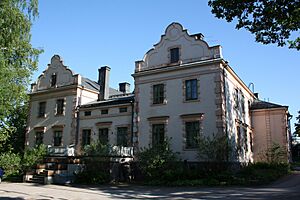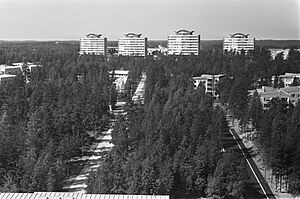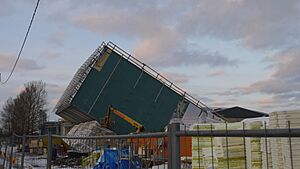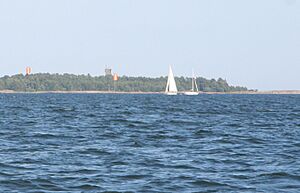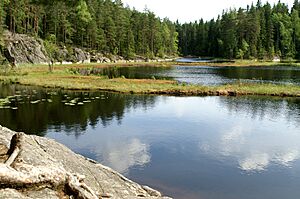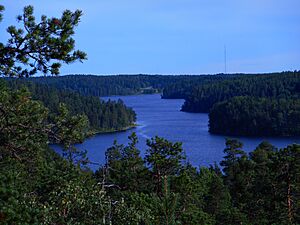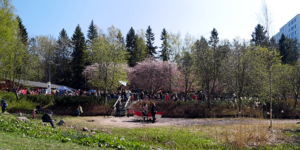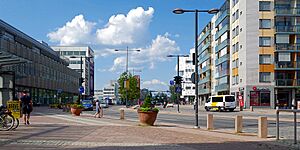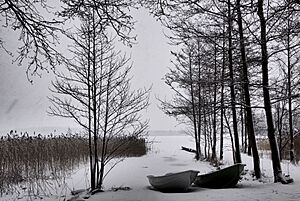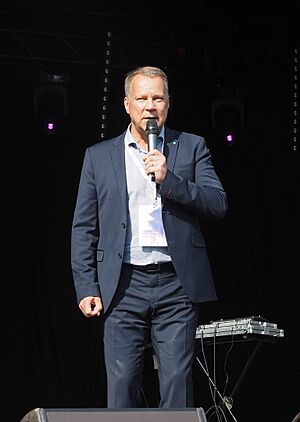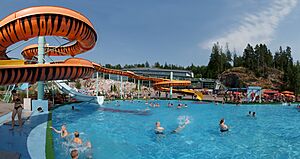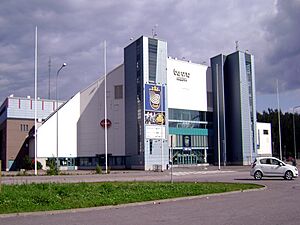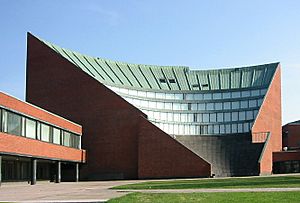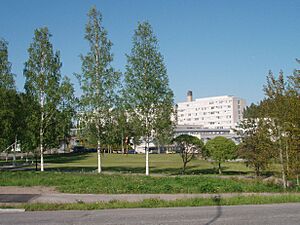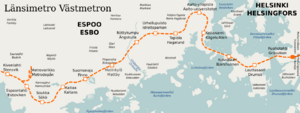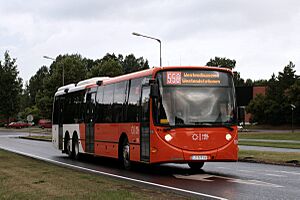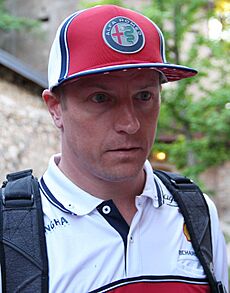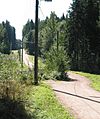Espoo facts for kids
Quick facts for kids
Espoo
Esbo
|
||
|---|---|---|
|
City and municipality
|
||
| City of Espoo Espoon kaupunki Esbo stad |
||
|
From top, left to right: Downtown Matinkylä; street in Espoonlahti; Aalto University Auditorium; Accountor Tower; Espoo Cathedral; Tapiola with Espoo Cultural Centre
|
||
|
||
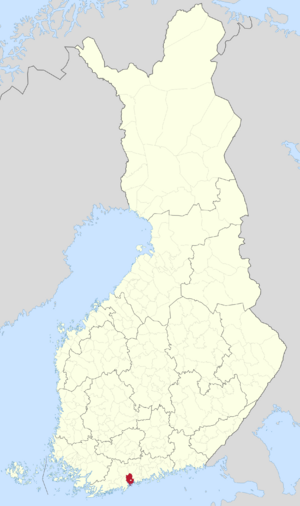
Location within Finland
|
||
|
OpenStreetMap
Interactive map outlining Espoo.
|
||
| Country | ||
| Region | ||
| Sub-region | Helsinki sub-region | |
| Metropolitan area | Helsinki metropolitan area | |
| Founded (parish) | 1458 | |
| Market town | 1963 | |
| Incorporated (city) | 1 January 1972 | |
| Area
(2018-01-01)
|
||
| • Total | 528.03 km2 (203.87 sq mi) | |
| • Land | 312.35 km2 (120.60 sq mi) | |
| • Water | 215.88 km2 (83.35 sq mi) | |
| Area rank | 230th largest in Finland | |
| Population
(2023-12-31)
|
||
| • Total | 314,024 | |
| • Rank | 2nd largest in Finland | |
| • Density | 1,005.36/km2 (2,603.9/sq mi) | |
| Population by native language | ||
| • Finnish | 69.9% (official) | |
| • Swedish | 6.4% (official) | |
| • Others | 23.6% | |
| Population by age | ||
| • 0 to 14 | 18.7% | |
| • 15 to 64 | 66.2% | |
| • 65 or older | 15% | |
| Time zone | UTC+02:00 (EET) | |
| • Summer (DST) | UTC+03:00 (EEST) | |
| Climate | Dfb | |
Espoo is a large city in Finland. It is located west of the capital city, Helsinki, in southern Uusimaa. Espoo is the second most populated city in Finland. It is part of the Helsinki Metropolitan Area, which is home to about 1.5 million people. Espoo sits on the northern shore of the Gulf of Finland. It shares borders with Helsinki, Vantaa, Kirkkonummi, Vihti, and Nurmijärvi. The city also completely surrounds the smaller city of Kauniainen. Espoo covers an area of 528 square kilometers.
Espoo is a bilingual city, meaning it has two official languages: Finnish and Swedish. Most people in Espoo speak Finnish. About 7% speak Swedish, and about 22% speak other languages.
People first lived in Espoo about 8,000 years ago. However, these early settlements disappeared. Later, during the Middle Ages, the area was settled by different Finnish groups. Swedish settlers also moved to the coastal areas. Espoo became an independent church area in the 1400s. When Helsinki became the capital of Finland in 1812, Espoo started to grow. For a long time, Espoo was mostly a farming area. After World War II, Espoo grew very quickly. More people moved there, and Finnish became the main language. Espoo became a market town in 1963 and a city in 1972.
Espoo is known for its many suburban homes. It also has beautiful nature, including a 58-kilometer coastline, many islands, forests, lakes, and a national park. Unlike many cities, Espoo does not have one main city center. Instead, it has five important centers: Leppävaara, Tapiola, Matinkylä, Espoon keskus, and Espoonlahti.
Aalto University is in Otaniemi, Espoo. It is a hub for science and new companies. Many big companies have their main offices in Espoo, like Nokia, KONE, and Neste. Game companies like Rovio (who made Angry Birds) and Remedy Entertainment are also here. In 2015, Espoo joined the UNESCO Global Network of Learning Cities.
Contents
History of Espoo
What's in a Name?
The name Espoo likely comes from the old Swedish village of Espaby. This village was in the western part of what is now Espoo. The name might refer to aspen trees that grew by a nearby river. The old Swedish word for aspen is "äspe," and "å" means river. The ending "-by" means village.
The coat of arms of Espoo shows a gold horseshoe with a gold crown on a blue shield. The crown stands for the old royal manor in Espoo. The horseshoe reminds us that parishes along the King's Road had to help transport officials or prisoners. Many roads in Espoo still follow this old medieval King's Road. This road was very important in Finland back then.
Early Times: Prehistory
People first lived in Espoo about 8,000 years ago. These were hunter-gatherers. Stone Age settlements have been found in areas like Nuuksio. Early metal age settlements show that people raised cattle. The first settlers lived in the northern parts of the city, near lakes. The southern parts were still covered by the sea. They lived near water for hunting and fishing. Their lives changed with the seasons.
During the Bronze Age (around 1500–500 BCE), people moved more to the south. Few settlements are known from this time. However, over 70 burial sites have been found, mostly in southern Espoo. When iron tools arrived around 500 BCE, it made life easier. But the climate got colder, and it seems people left Espoo for a while.
Swedish Rule and Medieval Life
Most of Espoo's first villages were founded by Finnish people called Tavastians. By the 1100s, there were Tavastian homes near lakes and in areas like Kauklahti. Later, Swedish settlers came to the area. They changed Finnish place names to Swedish ones. For example, Kauklahti became Köklax. The Swedish settlements were so widespread that most of the area became Swedish-speaking.
Farming was already happening in Espoo around the 1000s. Espoo became an independent church area in the 1400s. Before that, it was part of Kirkkonummi. The stone Espoo Cathedral was built in the 1480s. This marked Espoo's independence. The important King's Road from Stockholm to Vyborg passed through Espoo.
Royal Manor and Farm Life
In 1556, King Gustav Vasa decided to build a royal manor in Espoo. This manor helped the king manage the area and collect taxes. The city's main administrative center, Espoon keskus, grew around the church and the Espoo railway station.
In the 16th century, Espoo had many large farms. Farmers who owned horses for wars got lower taxes. By the late 1600s, noble families owned much of the land in Espoo. In the early 1700s, wars caused hardship. Many people moved to Sweden. The building of the Sveaborg fortress near Helsinki increased traffic in Espoo. Many officers bought summer homes here. New crops like potatoes also spread from the manors to the farmers.
Growth in the 1800s and Early Industry
Finland became part of the Russian Empire in 1809. When Helsinki became the capital in 1812, it helped Espoo grow. Many government officials and business people bought summer homes in Espoo.
Throughout the 1800s, most people in Espoo were farmers. The population was about 4,000. Most people lived in small villages. About 90% of the people spoke Swedish. Wealthy estates and manors needed workers for farming and raising animals. Fishing was also common near the coast. The Glims farmstead shows what rural life was like back then.
Espoo started to change in the late 1800s. Brick factories were built in Espoonlahti and Kauklahti. The clay from Espoo Bay was good for bricks. These bricks were sent to Helsinki by steamboat. For example, the Uspenski Cathedral in Helsinki was built with bricks from Espoo.
The Bastvik Sawmill, powered by steam, opened in 1876. A workshop for joiners (woodworkers) opened on Staffan island in 1886. This island became famous for its skilled woodworkers.
World War I and Civil War Changes
During World War I, Russia built a large fortification chain around Helsinki to protect it from Germany. This construction needed many workers. Many people from Espoo were asked to help build these defenses. The Russian Revolution in 1917 stopped the work. Finland became independent in December 1917. The fortifications were never used for their original purpose.
After the Russian Revolution, Finland faced a time of unrest. Local groups formed to keep order. In Espoo, these groups became more military-like. When the Finnish Civil War began in January 1918, the Red Guards took control of Espoo. There were no big battles in Espoo itself. The Reds took control peacefully. They set up a court and patrols. Some people fled Espoo during this time.
After the war, Espoo had little damage. However, many homes suffered from a lack of food. The situation improved by 1919. New laws helped farmers buy their own land.
Espoo in the 20th Century
In 1920, Espoo was still a rural area with about 9,000 people. Most of them (70%) spoke Swedish. Farming was the main way people earned a living.
Kauniainen separated from Espoo in 1920. Espoo started to grow very fast in the 1940s and 1950s. After World War II, many soldiers and people from areas given to the Soviet Union moved to Espoo.
Espoo's location next to Helsinki attracted many people who worked in the capital. New suburbs grew along the railway and new roads. After the war, many homes were built for soldiers. The biggest growth started in the 1950s. The Tapiola garden city was built, and a new campus for the Helsinki University of Technology (now Aalto University) started in Otaniemi.
Espoo grew so fast that its services struggled to keep up. There wasn't enough time for proper city planning. New houses were built wherever land was available. The Helsinki University of Technology moved to Otaniemi. Students even helped build their own dorms using bricks from a bombed embassy.
From 1944 to 1956, the Porkkala Naval Base was controlled by the Soviet Union. The border was near Espoo, and the Kauklahti railway station became a strict border crossing. Train windows had to be covered when passing through the Soviet-controlled area.
Unlike Helsinki, Espoo didn't develop one main city center. Instead, it became a city with many centers. This was partly because of a 1968 plan that divided Espoo into four areas. Also, most of the land was privately owned, not by the city.
Some parts of Espoo, like Tapiola and Leppävaara, tried to become independent cities or join Helsinki. But these attempts failed. Espoo officially became a market town in 1963 and a city in 1972. The new administrative center, Espoon keskus, was built in the 1970s.
Espoo's non-centralized nature led to big differences between its districts. Some were wealthy garden cities, while others were rural or new suburbs. This caused disagreements and gave Espoo a reputation for being a "quarrelsome" municipality.
By 1972, when Espoo became a city, its population was over 100,000. It was the fourth-largest city in Finland. Espoo grew quickly from a rural area to an industrial city. Its population grew from 22,000 in 1950 to 210,000 in 2000. Most new residents were Finnish-speaking. In 2022, Espoo's population grew to over 300,000.
Modern Espoo: 21st Century
By the early 2000s, Espoo was the second-largest city in Finland. The Länsimetro metro line started being built in 2010. Its first part opened in 2017, and the second part opened in 2022. This greatly improved public transport in Espoo.
Geography of Espoo
Land and Water Areas
Espoo covers 528 square kilometers. About 59% is land, and 41% is water. Most of the water is sea water from the Gulf of Finland. Espoo has a varied landscape. The southern part has a coastline and many islands. Central Espoo has lush river areas and fields. Northern Espoo has rocky terrain with many lakes, similar to the Finnish Lakeland. The highest point in Espoo is Velskola, at 114.2 meters above sea level.
Espoo is part of the Helsinki capital region. It has large natural areas for a city its size. The coastline is 58 kilometers long and has 165 islands.
Espoo's Rocky Foundation
The rocks and hills of Espoo were formed about 1.6 to 1.8 billion years ago. The Last Ice Age also shaped the land. The ice sheet melted about 13,000 years ago. The first areas to appear from under the sea were the high hills in northern Espoo. The smooth cliffs on the coast were worn down by the ice.
Espoo's bedrock includes different types of rocks like gneiss and granite. In many places, thick layers of clay cover the bedrock. These clay layers formed when ancient seas covered the area. The bedrock also shaped the coastline, creating bays like Espoonlahti.
The Sea Around Espoo
Espoo's sea area is a narrow strip between Helsinki and Kirkkonummi. The outer islands are small and treeless. One example is Kytö, a former fortification island. These small islands are important nesting places for birds. Many are protected nature areas. The islands closer to the shore, like Stora Herrö, are larger and greener. They have vacation homes and some permanent settlements.
The sea extends inland as bays, like Espoonlahti and Laajalahti. These bays are shallow and have many islands. The largest peninsula in Espoo is Soukka. Espoo has many small boat harbors. The largest is in Suomenoja.
Espoo's Shoreline
Espoo's shoreline is about 58 kilometers long and has 165 islands. The shoreline is very diverse. It has bays, reed beds, sandy beaches, cliffs, and boat harbors. Most of Espoo's shoreline is open for public use. The Rantaraitti hiking path runs along almost the entire coast. The land in Espoo is slowly rising from the sea, about a quarter of a meter per century. This causes some moist areas to become bogs.
Nature on Land
Espoo has six Natura 2000 protected areas. These include forests, bays, and bogs. The forests are mostly pine and spruce, with some deciduous trees like oak. The Espoo Central Park is a large natural area in the middle of the city. It has forests and meadows.
The most famous nature area is the Nuuksio National Park in northern Espoo. It has forests, lakes, small bogs, and meadows. The highest point in Espoo, Mustankorvenkallio, is in Velskola.
Lakes and Rivers
Espoo has over a hundred lakes and ponds. The lakes formed as the land rose after the Ice Age. The oldest lakes are high above sea level. As the sea level dropped, new lakes formed. Many lakes are in the northern part of Espoo, especially in the Nuuksio highlands.
The largest lake in Espoo is Lake Bodom, which is 4.1 square kilometers. Nuuksion Pitkäjärvi is also a large lake. There are few islands in Espoo's inland lakes. The differences in lake heights can create small rapids in creeks.
Animals and Plants of Espoo
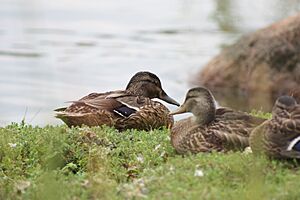
Espoo's Central Park has typical Finnish forest animals. Common mammals include hares, raccoon dogs, squirrels, elk, red foxes, badgers, and deer.
The Suomenoja Bird Reserve is important for its many bird species. You can find endangered moorhens, horned grebes, and gadwalls. Common sea birds include black-headed gulls and whooper swans. White-tailed eagles can also be seen in the archipelago.
Espoo is home to 73 vulnerable or endangered species. This includes the Siberian flying squirrel, which is Espoo's official animal. Its populations have decreased due to logging. Flying squirrels are found in northern Espoo and some southern areas like Central Park and Tapiola. Espoo's official bird is the common blackbird, and its official plant is Anemone nemorosa.
Climate in Espoo
Temperature and Rainfall Patterns
Espoo's weather changes quickly because it is located between the large continent of Eurasia and the Atlantic Ocean. The Gulf of Finland also affects the climate. It cools the weather in summer and warms it in autumn. The Nuuksio area has more rainfall than the rest of Espoo because of its hills. In 1981, Nupuri in Espoo had a record 1,109 millimeters of rain.
The average temperature in nearby areas is about 5 to 6 degrees Celsius. The coldest months are January and February. The warmest months are July and August. Temperatures near the coast rarely go above 30 degrees Celsius or below -20 degrees Celsius. The average rainfall is 600 to 700 millimeters per year. The driest time is spring, and the rainiest is autumn.
Snow and Wind Conditions
Snow usually falls in Espoo after Christmas and melts by late March or early April. Snow conditions vary more on the coast than inland. Sometimes, there is very little snow during winter.
The most common wind direction in Espoo is southwest. The sea wind greatly affects local winds on the coast. In spring and early summer, the sea wind often keeps the coast clear of clouds, while inland areas might have clouds and rain.
Air Quality and Daylight
Espoo's air quality is generally good, even with traffic. However, in springtime, dust from sand used on roads can be a problem. Pollen from alder and birch trees affects air quality in spring.
Espoo is located far north, so daylight hours change a lot. In summer, daylight lasts for 19 hours. In winter, it lasts only six hours. In summer, it never gets completely dark at night. In winter, daylight is very short, especially from November to January.
How Espoo is Governed
Espoo is part of the Uusimaa region. The main decisions for the city are made by the City Council of Espoo. The council has 75 members, who are elected every four years.
City Areas and Districts
Espoo is divided into seven main areas: Vanha-Espoo (which has the administrative center), Suur-Espoonlahti, Pohjois-Espoo, Suur-Kauklahti, Suur-Leppävaara, Suur-Matinkylä, and Suur-Tapiola. Suur-Leppävaara has the most people. These main areas are then divided into 56 smaller districts. City services like healthcare, schools, and cultural centers are found in these regional centers.
The population of Espoo has grown a lot in recent years. From 2011 to 2022, Suur-Kauklahti grew by about 70%.
City Leaders
The city manager leads the daily operations of Espoo. This role was first filled in 1962. The current city manager is Jukka Mäkelä.
City Council Politics
Politically, Espoo is a "bourgeois" city, meaning that parties that support businesses and individual freedoms are strong. The largest party is the National Coalition Party. The Green League and the Swedish People's Party of Finland also have strong support in Espoo.
People of Espoo
Population Growth
Espoo has over 300,000 people, making it the second most populated city in Finland. It is part of the Helsinki metropolitan area, which has over 1.5 million residents. About 5% of Finland's total population lives in Espoo.
About 22% of Espoo's population has a foreign background. This is much higher than the national average for Finland. In 2022, the average age in Espoo was 39.0 years, which is younger than the average age in Finland (43.7 years). In 2021, people in Espoo had the second highest average income in Finland.
Languages Spoken
Population by mother tongue (2023) Finnish (69.9%) Swedish (6.4%) Russian (3.4%) Arabic (1.9%) Estonian (1.8%) English (1.7%) Chinese (1.3%) Other (13.5%)
Espoo is officially bilingual, with Finnish and Swedish as its official languages. In 2023, about 70% of people spoke Finnish as their first language. About 6.4% spoke Swedish. A small number of people (about 100) speak Sámi, Finland's third official language. About 22% of the population speak a language other than Finnish or Swedish as their first language.
Learning English and Swedish (or Finnish for Swedish speakers) is required in school. So, many people in Espoo can speak two or three languages. The number of people who speak other languages is expected to grow to 30% by 2030.
The number of Swedish speakers decreased a lot in the 1950s. This was because many Finnish speakers moved to Espoo as the city grew fast. In 2022, Swedish speakers made up 6.6% of the population.
The proportion of Finnish speakers has gone down over the last 20 years. In 1999, 88% spoke Finnish. In 2022, it was 76.1%. At the same time, the number of foreign language speakers has increased a lot. The largest group of foreign language speakers are those who speak Russian.
People from Other Countries
| Population by country of birth (2022) | ||
| Nationality | Population | % |
|---|---|---|
| 246,155 | 80.6 | |
| 5,768 | 1.9 | |
| 5,644 | 1.8 | |
| 3,860 | 1.3 | |
| 3,238 | 1.1 | |
| 3,236 | 1.1 | |
| 2,325 | 0.8 | |
| 1,899 | 0.6 | |
| 1,814 | 0.6 | |
| 1,598 | 0.5 | |
| 1,550 | 0.5 | |
As of 2023, about 23.8% of Espoo's population had an immigrant background. This means they or their parents were born abroad. The largest groups are from the former Soviet Union, Estonia, India, Iraq, and China. The number of people from India has grown a lot recently.
Religious Groups
In 2023, the Evangelical Lutheran Church was the largest religious group in Espoo, with 50.3% of the population. Other religious groups made up 3.8%. About 45.9% of the population had no religious affiliation.
Espoo has five Lutheran churches, including the Espoo Cathedral. There are also 27 chapels. The Helsinki Orthodox Congregation has a church in Tapiola.
Economy of Espoo
From Farms to Modern Business
In the mid-1800s, Espoo was mostly a farming community. There was little industry. About 90% of men worked in farming. Some women worked as maids.
Small-scale mining for ore happened in the 1840s and 1850s, but not much ore was found. As Helsinki grew, people from Espoo started working there. Travel was slow, so many moved to Helsinki.
The first industrial area in Espoo grew near the Espoonlahti bay. Brick factories and a sawmill were built there. Clay from the bay was good for bricks, which were sent to Helsinki by sea. The Uspenski Cathedral in Helsinki was built with Espoo bricks. When the Rantarata railway was completed in the early 1900s, more industries moved near the railway. This also made it easier for people to travel to work in Helsinki.
Espoo also had a glass industry. A bottle glass factory opened in 1912 but closed in 1922. The Kauklahti glass factory, which made lighting glass, was the largest in Finland in the 1930s. It closed in 1951.
By the late 1930s, Espoo had about 30 businesses. These included machinery workshops, sawmills, and metalworking shops. There was also clothing manufacturing and a clock factory. The first shop in Espoo opened in 1868. By the time Finland became independent, there were about 40 shops.
Even with growing industry, Espoo was still mostly rural in 1920. About two-thirds of the people earned their living from farming. Rye and barley were the main crops for centuries. Later, raising cattle and growing oats became more popular.
Construction and services became the main parts of Espoo's economy in the 1950s. Today, the biggest industries are trade, hotels, restaurants, and specialist services. Technology and communications are also very important. About a quarter of jobs are in the public sector. Farming and forestry now make up a very small part of the economy.
Major Companies in Espoo
Espoo is home to the main offices of many global and high-tech companies. The Aalto University campus is a center for research and development. Companies like Nokia, Valmet, Remedy Entertainment, Fortum, and Neste have their headquarters here. Because of these companies, Espoo is a leader in patents filed in Finland.
The largest shopping centers in Espoo are Iso Omena, Sello, Lippulaiva, Entresse, and Ainoa.
City Finances and Income
The city of Espoo pays for its services mainly through taxes. In 2021, the city's tax income was 1.7 billion euros. The city of Espoo is also the biggest employer in the city, with about 14,000 employees in 2016.
Espoo's average income is higher than in the rest of Finland. In 2015, the taxable income in Espoo was 40% higher than the national average. The highest-income areas are usually along the coast, like Westend. Areas with detached houses generally have higher incomes than areas with apartment buildings.
Culture in Espoo
Espoo has a modern art museum called EMMA. It is in the WeeGee house, an old printing house. The same building also has Finland's only Museum of Horology (clocks) and a Toy Museum. The Glims Farmstead Museum shows what rural life was like.
The Espoo Cultural Centre in Tapiola hosts many concerts and theater shows. It is home to the famous Tapiola Sinfonietta orchestra. The Akseli Gallen-Kallela Museum is in Tarvaspää, and the Haltia Nature Centre is in Nuuksio.
Espoo has several old manors. Two are open to the public. The most important is Espoon kartano (Espoo Manor), first mentioned in 1495. The current main building was built in 1914. Finland's oldest walled stone bridge from 1777 is on the King's Road near the manor.
Famous metal bands like Children of Bodom, Norther, and Kiuas come from Espoo.
Events and Festivals
Tapiola hosts the annual film festival Espoo Ciné and the music festival April Jazz. Leppävaara has the annual music festival Kivenlahti Rock. In winter, the Serena Waterpark hosts the Pacifique spa party. The Espoo Cathedral hosts the "Urkuyö ja aaria" concert event in summer. Ropecon, a large role-playing game convention, used to be held at the Dipoli conference center.
Food and History
In the 1980s, traditional Espoo dishes included cod potatoes and fisherman's herring pan. A fancy meal at the Espoo manor might have included roasted veal and ice cream.
Espoo's cultural landscape developed in river valleys and on clearings near bays. Old villages were small, often with two or three houses on a hill. The King's Road brought new ideas and influences. In the late 1800s, new villas (large country houses) were built on the coast because of steamship traffic. Many of these villas were designed by famous architects.
The railway, completed in 1903, also changed Espoo. Industrial buildings and working-class settlements grew near the stations. Espoo was seen as a healthy place to live compared to Helsinki.
Sports in Espoo
Espoo has hosted major sports events. The city's Westend Tennis Hall hosted the fencing events during the 1952 Summer Olympics.
Many famous athletes are from Espoo. These include ice hockey players Teemu Selänne and Jere Lehtinen, swimmer Antti Kasvio, figure skater Laura Lepistö, javelin thrower Tiina Lillak, cross-country skier Marjo Matikainen, and Formula 1 world champion Kimi Räikkönen.
Espoo has the Vermo race track, the Espoo Metro Areena (a sports and entertainment center), and several sports parks like Tapiolan urheilupuisto and Leppävaaran urheilupuisto. The largest swimming pools are in Leppävaara, Keski-Espoo, Espoonlahti, and Tapiola. You can also exercise in the Espoo Central Park and on the Espoo outdoor islands.
Sportsperson of the Year
Every year, Espoo chooses a sportsperson of the year.
- 2014: Gymnast Saga Hänninen, who won gold at the Special Olympics.
- 2015: Archer Jarkko Lehtinen.
- 2016: Artistic gymnast Oskar Kirmes, who was the first Finnish man in 44 years to compete in Olympic artistic gymnastics.
- 2017: Shooter Cristian Friman, who won the youth world championship.
Team Sports
- Basketball: The Espoo Metro Areena will host the FIBA Women's EuroBasket in 2027.
- Ice Hockey: The Espoo Blues was a successful hockey club. Their women's team, Espoo Blues Naiset, won 13 Finnish championships. The club faced financial problems and declared bankruptcy in 2016. A new club, Espoo United, was formed but also went bankrupt. In 2019, the women's team merged with a junior club to become Kiekko-Espoo Naiset. They are the most successful team in women's league history.
- Football: FC Honka is Espoo's most successful professional football club. Their men's team plays in the Finnish premier division.
- Floorball: Espoo has two floorball teams, Esport Oilers and Westend Indians, that play at the highest level.
Running Events
Espoo hosts the Länsiväyläjuoksu, an annual running event that starts and finishes in Otaniemi.
City Services
Education for All Ages
The Aalto University campus is in Otaniemi, Espoo. It includes all six of the university's colleges. Espoo also has the Metropolia University of Applied Sciences and local colleges of the Laurea University of Applied Sciences. Music schools like Juvenalia and the Espoo Musical Institute are also in the city.
Healthcare Services
The Jorvi Hospital in Espoo works with the Helsinki University Central Hospital. It is part of the Hospital District of Helsinki and Uusimaa. Espoo has ten healthcare stations that provide local health services.
Getting Around Espoo
Espoo has good road connections. Two major highways, Länsiväylä and Finnish national road 1, go through the city. These roads connect to beltways like Ring I, Ring II, and Ring III, which help traffic flow around the Helsinki area.
Public Transportation
Espoo has excellent public transport. This includes the Helsinki commuter rail network, the Helsinki Metro's Länsimetro extension, and buses. In 2024, the new Jokeri light rail line will connect Espoo to eastern Helsinki.
Metro System
The Länsimetro metro extension opened in two phases. The first phase opened in 2017 with six stations: Keilaniemi, Aalto University, Tapiola, Urheilupuisto, Niittykumpu, and Matinkylä. The second phase, with five more stations, opened in 2022.
Train Connections
Espoo has nine railway stations. Only the Leppävaara railway station serves long-distance trains. It is the busiest station in Espoo. Local trains run frequently on the Rantarata railway. These trains connect Espoo to Helsinki and other nearby towns. All local trains from Espoo stop at Pasila railway station, where you can connect to trains going to Tampere. You can also connect to a train to Helsinki Airport from Huopalahti railway station.
Bus Services
Many bus lines serve Espoo. The Helsinki Regional Transport Authority plans the bus routes and tickets. Bus line 200 is a main line that travels between Espoon keskus and central Helsinki. Bus lines in southern Espoo often go to the Matinkylä metro station or directly to Helsinki. There are also internal bus lines within Espoo. The Joker line 550 travels around Helsinki, bypassing the city center.
Espoo's International Friends
The City of Espoo has eight official sister cities around the world:
 Esztergom, Hungary
Esztergom, Hungary Irving, Texas, United States
Irving, Texas, United States Køge, Denmark
Køge, Denmark Kongsberg, Norway
Kongsberg, Norway Kristianstad, Sweden
Kristianstad, Sweden Nõmme, Estonia
Nõmme, Estonia Shanghai, China
Shanghai, China Skagafjörður, Iceland
Skagafjörður, Iceland
Famous People from Espoo
Many well-known people come from Espoo, including:
- Susan Aho (born 1974), singer from the band Värttinä
- Peter Ahola (born 1968), former NHL ice hockey player
- Niklas Hagman (born 1979), ice hockey player
- Miro Heiskanen (born 1999), ice hockey player
- Ella Junnila (born 1998), athlete
- Henri Kontinen (born 1990), tennis player
- Krista Kosonen (born 1983), actress
- Noora Räty (born 1989), ice hockey player
- Alexi Laiho (1979–2020), guitarist and singer, co-founder of the band Children of Bodom
- Jere Lehtinen (born 1973), ice hockey player
- JJ Lehto (born 1966), racing driver
- Laura Lepistö (born 1988), figure skater
- Sami Lepistö (born 1984), ice hockey player
- Anton Lundell (born 2001), ice hockey player
- Pekka Lundmark (born 1966), businessman
- Ukko-Pekka Luukkonen (born 1999), ice hockey goaltender
- Kimi Räikkönen (born 1979), former racing driver and 2007 Formula One World Champion
- Tony Salmelainen (born 1981), ice hockey player
- Rasmus Schüller (born 1991), football player
- Joonas Suotamo (born 1986), actor (Chewbacca in Star Wars) and former basketball player
- Gösta Sundqvist (1957–2003), bandleader of Leevi and the Leavings
- Antti Törmänen (born 1970), ice hockey coach
- Aaro Vainio (born 1993), racing driver
- Ville Virtanen (born 1961), actor
- Mirel Wagner (born 1987), singer
Images for kids
-
Evangelical Lutheran Cathedral in Espoo, originally built as a Catholic parish church in the 1480s.
-
The Royal Manor in Espoo, founded by King Gustav I of Sweden in 1556.
See also
 In Spanish: Espoo para niños
In Spanish: Espoo para niños









